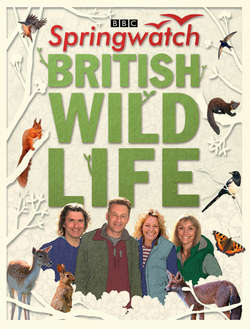Читать книгу Springwatch British Wildlife: Accompanies the BBC 2 TV series - Stephen Moss - Страница 9
ОглавлениеBlackbird, Song Thrush & Mistle Thrush
©Bill Coster/FLPA
Blackbirds often feed on berry bushes in winter to supplement their energy needs.
These are three of our most familiar birds, with distinctive and well-loved songs: the blackbird and song thrush regularly top the hit parade of Britain’s favourite songsters. All three are resident, though numbers are supplemented each autumn and winter with new arrivals from across the North Sea, taking advantage of our milder climate. All three are also well adapted to gardens, though the mistle thrush is also commonly found in more open countryside and parkland, with tall trees from which it can deliver its song.
Indeed, the mistle thrush is often one of the first songbirds to sing, at the start of the new year – even earlier during mild winters. Thomas Hardy wrote a famous poem, The Darkling Thrush, which celebrates a thrush singing during blustery weather on New Year’s Eve; many people think that this early date and the bad weather point to this being a mistle, rather than a song, thrush. Mistle thrushes have earned the folk name ‘stormcock’ for their habit of singing through the worst of the British weather.
The song thrush is usually the next of the trio to sing, usually starting off in January or early February. Its song is probably the most distinctive of all our birds: measured phrases, repeated in twos or threes, as if the bird were talking to you! Soon afterwards the blackbird joins in, deeper than the song thrush, with a really fluty tone.
All three birds often choose a high perch from which to deliver their songs, which makes them easy to see. This is a good time of year to get to grips with the differences between them. Male blackbirds are easy: coal-black in colour, with that distinctive bright custard-yellow bill and – if you get close enough to see it – a yellow ring around the eye. Female blackbirds, which tend to be more skulking in habit, are chocolate-brown above and below.
The two thrushes are harder to tell apart, though with practice not too tricky. The mistle thrush is much larger, paler and greyer, with heavy spotting below and a permanently surprised expression on its face. Song thrushes are smaller, plumper and a deeper brown colour, and with a much more kindly expression! Beware young blackbirds, especially in late summer, which can be a bit streaky below and a little thrush-like.
These birds’ nests are easy to find too, often tucked away in a shrub or bush or, in the case of the mistle thrush, in the fork of a tree. All three start to breed very early on, and sometimes have eggs (and occasionally even chicks) before Christmas or early in the new year. The two thrushes have two broods – the song thrush sometimes three – but blackbirds really are the champion nesters, often raising three, four or even five broods of chicks in a single breeding season. This avoids the ‘putting all your eggs in one basket’ problem faced by blue tits, and means that even if there is prolonged bad weather during some parts of the breeding season, they can usually get at least one brood of chicks to fledging.
The blackbird and mistle thrush eat a wide range of foods, including snails and worms as well as berries and fruit – a mistle thrush will often spend the winter defending a single berry bush against all-comers. Song thrushes are more carnivorous, feeding mainly on slugs and snails, which they bash on a heavy stone, known as an ‘anvil’, to get them out of their shells. Song thrushes suffer badly from poisoning by agricultural and garden pesticides, especially slug pellets – being a natural pest controller, they should be welcomed into the garden! In autumn and winter, all three species, but especially blackbirds, will feed on windfall apples.
The availability of food and places where the birds can nest means that gardens are incredibly important for both blackbirds and song thrushes – they nest there in densities up to ten times greater than in their natural woodland habitats.
©John Hawkins/FLPA
©Steve Young/FLPA
Mistle thrush and song thrush enjoy a varied diet, including fruit as well as insects, snails and slugs.
